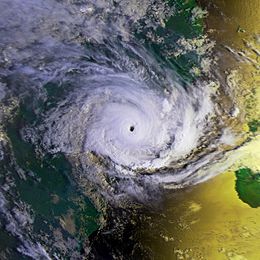Cyclone Eline
| Intense tropical cyclone (SWIO scale) | |
|---|---|
| Category 4 (Saffir–Simpson scale) | |

Cyclone Eline at landfall in Mozambique
|
|
| Formed | February 1, 2000 |
| Dissipated | February 29, 2000 |
| Highest winds |
10-minute sustained: 185 km/h (115 mph) 1-minute sustained: 215 km/h (130 mph) |
| Lowest pressure | 928 hPa (mbar); 27.4 inHg |
| Fatalities | 114–722 |
| Areas affected | Madagascar, much of southern Africa (mainly Mozambique) |
| Part of the 1999–2000 Australian region and South-West Indian Ocean cyclone seasons | |
Cyclone Leon–Eline was the longest-lived Indian Ocean tropical cyclone on record, traveling over 11,000 km (6,800 mi) during its 29‑day duration. It formed on February 1, 2000, in the Australian basin as Tropical Cyclone Leon. After crossing 90° E, the Météo-France office in Réunion (MFR) began tracking the system as Tropical Storm Eline on February 8. Late on February 17, Eline made landfall near Mahanoro, Madagascar, with 10‑minute winds of 165 km/h (103 mph). The storm rapidly weakened over land, but restrengthened in the Mozambique Channel to reach peak 10‑minute winds of 185 km/h (115 mph). On February 22, Eline made landfall about 80 km (50 mi) south of Beira, Mozambique, near peak intensity, and quickly weakened over land. The well-defined circulation moved across southern African, finally dissipating over eastern Namibia on February 29.
While moving across much of the Indian Ocean, Eline brought high waves, gusty winds, and rainfall to several islands. Later, Eline struck Madagascar while the country was in the midst of a cholera epidemic that had killed over 1,000 people. The storm directly killed at least 64 people, although Tropical Storm Gloria struck shortly thereafter, compounding upon the damage and making it difficult to discern the individual damage totals. Damage from Eline was estimated at $9 million (USD), and collectively the two storms killed 205 people and left another 10,000 homeless. In the region around Vatomandry, where Eline made landfall, 65% of houses were damaged, 90% of crops were lost, and 75% of health facilities were wrecked.
Before Eline's final landfall, Mozambique was experiencing the worst floods since 1951, killing about 150 people. The additional rainfall and flooding from Eline created the country's worst natural disaster in a century. The combined effects destroyed over 250,000 ha (620,000 acres) of crop fields and killed 40,000 cattle. Eline's passage disrupted ongoing relief efforts. High levels along the Limpopo River isolated the town of Xai-Xai, with water levels along the river reaching as high as 11 m (36 ft) above normal in some areas, as well as 15 km (9.3 mi) wide. A dam broke along the river, flooding the town of Chokwe in the middle of the night and trapping several unprepared residents; this accounted for nearly half of the death toll. About 55 people drowned in Sofala Province after rescue helicopters arrived too late to save them. Around 20,000 people in the capital city of Maputo lost their homes. In addition to the floods, strong winds blew away many roofs and some entire houses made of mud. The combined effects of the preceding floods and Eline left about 329,000 people displaced or homeless, about 700 deaths, and damage estimated at $500 million (USD). The cyclone and the floods disrupted much of the economic progress Mozambique had made in the 1990s since the end of its civil war.
...
Wikipedia
